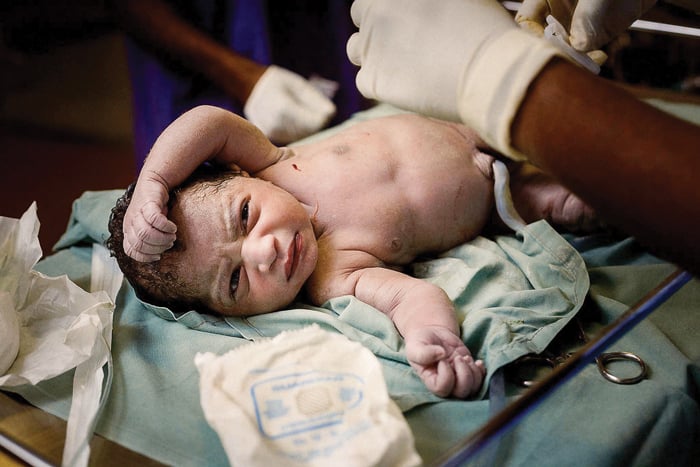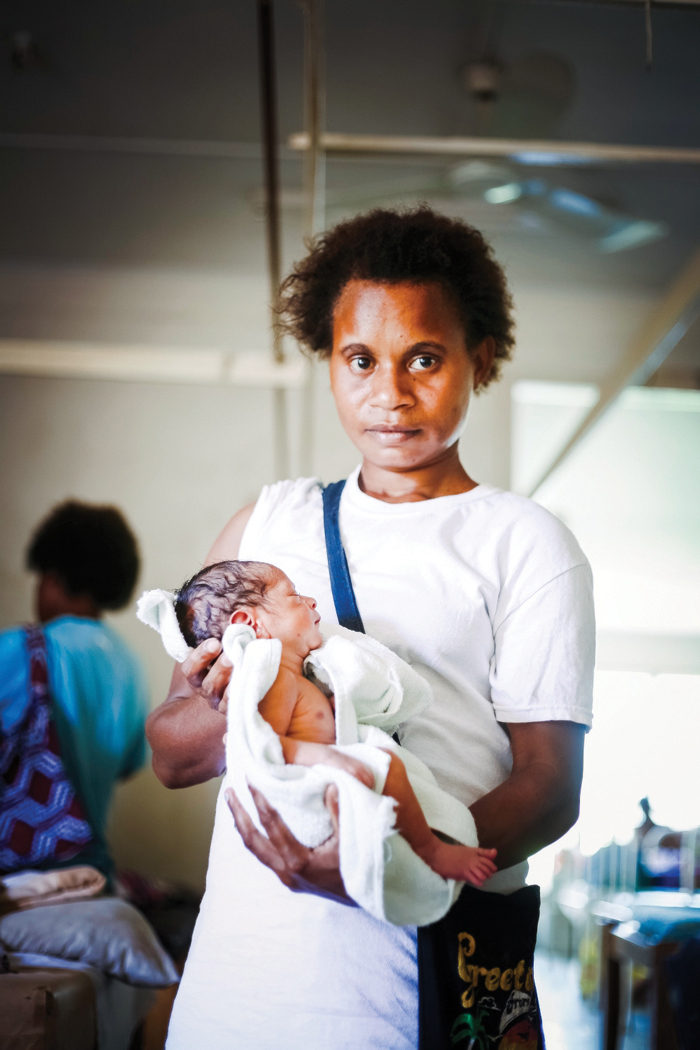In Australia, the caesarean section rate is currently about 30 per cent,1 but at Port Moresby General Hospital (PMGH), in Papua New Guinea’s capital, it is about 6 per cent.2 It appears that there are two reasons for the lower section rate at PMGH. The first pertains to inadequate resources or health and state infrastructure that would not be able to sustain a rate much higher than this, and the second to the practice of careful obstetrics that aims to optimise safe, supervised and successful vaginal delivery. This is achieved with a perinatal mortality rate of less than 30 per 1000 babies that are born to the mothers who book at PMGH’s antenatal clinics: this is one of the lowest perinatal mortality rates for any capital city maternity hospital in the developing world.3
Even if it is safe for a woman to have a caesarean section at PMGH, there is no guarantee that it is immediately possible, because of the lack of anaesthetic support or because the water supply to the theatre has been cut, making cleaning instruments and the operation of theatre impossible. Blood is often in short supply and blood products (for example, platelet concentrate) are rarely available, making any operation on a woman unsafe and unwise, especially on those who are severely anaemic4 (about 10 per cent of those presenting for delivery, often owing to nutritional deficiencies or lack of sufficient birth spacing) or whose clotting potential is precarious already (in other words, cases of severe preeclampsia or disseminated intravascular coagulation).5
Doctors and midwives at PMGH work in difficult circumstances, particularly when compared to health professionals working in an urban centre in Australia. Medical necessities on the ward, such as gloves, are often out of stock or in very short supply. During the month I was there on my elective in 2016, and also for the month that followed, the labour ward staff had to make do with one (repeatedly washed and resterilised in glutaraldehyde) disposable amniohook for artificial rupture of membranes. There were also no HIV test strips to continue the essential ‘Prevention of Mother to Child Transmission Program’ for HIV. Sometimes, the staff have to buy essential supplies with their own money. Suture trays are often unavailable, leaving midwives or doctors having to repair tears with any equipment they can find and using any spare light they can borrow. However, amid all of this, those working somehow find a way to get the job done. Gloves are used as tourniquets, pieces of cloth as theatre caps, and nappies as means to arrest bleeding. The health personnel are resourceful and efficient. They have to be.
Many serious obstetric presentations come in the door every day. Women with little or no antenatal care may have a placental abruption or have given birth to a stillborn baby in the carpark. Women arrive in profound shock, having suffered a ruptured uterus; or present late, post-term and fully dilated with all manner of complications.6 Tuberculosis (three out of 17 maternal deaths in 2016 could be attributed to TB) and HIV-related sepsis (2 per cent of maternal mortality in 2016) contribute significantly to the maternal mortality rate (MMR).7 The PMGH MMR was 120 per 100 000 in 2016.8 All levels of staff face these sobering clinical realities on a daily basis.
At PMGH, 45 babies are born on average every day, compared to approximately ten births a day in major Sydney maternity units. I saw many women forced to deliver on the floor because the labour ward, with only 24 beds, is so overcrowded. The use of pethidine, in the absence of any accessible epidural service, increases the need for opiate reversal in the immediate postpartum period to enable the newborn to breathe. Many babies are resuscitated in the hospital hallway by resilient medical staff, who have little option in the face of overcrowding and lack of sufficient medical services and dedicated special-purpose space.

In Papua New Guinea, over 80 per cent of the population live in remote and inaccessible areas of the country. Doctors working at PMGH need to be aware of the isolated home origin of their patients and the likely lack of obstetric help in the next pregnancy.9 For this reason, there is a tendency to persist with attempts at vaginal delivery whenever it is reasonable to do so. Doctors will avoid caesarean births, as long as it is safe for the mother and the child, because the risk of uterine rupture is increased for women who experience subsequent pregnancies in remote communities far from medical assistance. Labours for vaginal births in PMGH are sometimes augmented for long periods in the face of slow progress, requiring staff to agonise over continuing adequate fetal condition. The instrumental delivery rate is about the same as the caesarean rate and occasionally leads to scalp trauma (subgaleal haemorrhage), requiring fluid resuscitation of the neonate. The staff are, however, undeniably committed to saving lives and make tough decisions humanely and with the best intentions for the welfare of women and their babies.
Doctors and nurses also put a lot of effort into family-planning counselling to help women leave the cycle of repeatedly closely spaced pregnancies that can put their own, and their children’s lives, at risk.10 Counselling can sometimes be quite direct, with mention made of the increased risk of future and immediate pregnancies: increased poverty for the family, lack of opportunity for education for children, unsafe abortions (often complicated by sepsis),11 malnutrition and death.12 Tubal ligation is strongly encouraged for those who do not want any more children and postpartum contraceptive implants are made available for those who do not want another pregnancy within the next four to five years.
As a final-year medical student from Sydney undertaking an elective period at PMGH, I became educated very quickly regarding the challenging conditions for both patients and medical staff at the hospital. My host family, socially concerned Papua New Guineans, were able to enlighten me a little about the social and political circumstances in the country, which also had serious impact on the hospital. I learned, for instance, that in some areas there is great pressure on women to have many children. Large families are thought by some (mostly rural) people to be indicators of abundance and wealth. Land ownership is highly valued and the greater the number of children a man has, the more he is able to cultivate the land he can make a claim to. A man intending to marry will cultivate and plant his land with food and cash crops. Wealth may then impress his intended wife. The man’s family will pay the ‘bride price’ to the woman’s family and seal the marriage. As her family has been paid handsomely by her husband’s family, the wife can feel enormous pressure to honour the transaction by producing many children. In the past, the ‘bride price’ was a way of strengthening ties between clans, but nowadays it has become, in some instances, an instrument of female oppression. A woman who becomes victim of a dysfunctional and violent relationship may be unable to divorce without repaying the bride price.
Women fear violence beyond the home, too. I witnessed much systemic violence on the streets of Port Moresby during my stay. Car windscreens are smashed; a great number of security guards are located at supermarkets, outside homes and hospitals; police are often seen chasing ‘rascals’, who are thought to have committed street crimes; drivers returning home wait on their street, rather than in their driveway, for the gate to be opened from the inside to avoid the likelihood of car jacking; and knife fights occur in the street. This can happen even in Port Moresby, where disconnected rural people are attempting to live on land that they have no customary right to own. Whole groups of people fight because individuals mobilise their tribesmen when they have a problem. It is too dangerous to act on your own. Authorities struggle to maintain order and basic services in a fragmented society.
Australian practitioners should think about making a contribution to our nearest neighbour, Papua New Guinea, and gain, as I did, some valuable medical experience in challenging circumstances, by working alongside the courageous and committed local health professionals at PMGH, or by assisting them in disseminating family planning information and providing contraception so that women have more control over their fertility. There are many complex issues that affect delivery of healthcare on Australia’s doorstep. Those I worked alongside at PMGH are heroic pragmatists and, as good neighbours, it is our responsibility to give them all the help and support we can.
*Not her real name
Acknowledgement
I wish to acknowledge Prof Glen Mola FRANZCOG, head of O&G School of Medicine and Health Sciences, UPNG, who contributed to this article and supervised me while on placement at PMGH.
References
- ‘Australia’s mothers and babies 2014—in brief.’ Perinatal Statistics Series 2016, no. 32. Cat no. PER 87. Canberra: AIHW.
- Amoa, A ‘Annual Report 2016, Port Moresby General Hospital, Division of Obstetrics and Gynaecology 2016, p3.
- Amoa, A ‘Annual Report 2016, Port Moresby General Hospital, Division of Obstetrics and Gynaecology 2016, p3.
- Sanga, K et al. A Review of Maternal Deaths at Goroka General Hospital, Papua New Guinea 2005-2008, Australian and New Zealand Journal of Obstetrics and Gynaecology 2010, 50: 23.
- Amoa, A ‘Annual Report 2016, Port Moresby General Hospital, Division of Obstetrics and Gynaecology 2016, p3.
- Sanga, K et al. A Review of Maternal Deaths at Goroka General Hospital, Papua New Guinea 2005-2008, Australian and New Zealand Journal of Obstetrics and Gynaecology 2010, 50: 23.
- Amoa, A ‘Annual Report 2016, Port Moresby General Hospital, Division of Obstetrics and Gynaecology 2016, p3.
- Amoa, A ‘Annual Report 2016, Port Moresby General Hospital, Division of Obstetrics and Gynaecology 2016, p3.
- Sanga, K et al. A Review of Maternal Deaths at Goroka General Hospital, Papua New Guinea 2005-2008, Australian and New Zealand Journal of Obstetrics and Gynaecology 2010, 50: 23.
- Mola, G et al. ‘Unintended Pregnancy Amongst Women Attending Antenatal Clinics at Port Moresby General Hospital,’ Australian and New Zealand Journal of Obstetrics and Gynaecology 2014, 54: 360.
- Sanga, K et al. A Review of Maternal Deaths at Goroka General Hospital, Papua New Guinea 2005-2008, Australian and New Zealand Journal of Obstetrics and Gynaecology 2010, 50: 23.
- Sanga, K et al. Unintended Pregnancy Amongst Women Attending Antenatal Clinics at Port Moresby General Hospital. Australian and New Zealand Journal of Obstetrics and Gynaecology 2014, 54: 364.







Sobering, yet amazing insight into your experience in Papua New Guinea. I am currently a medical student at the University of Melbourne considering a medical elective with Dr Glen Mola this year. Is there a good way for me to find out more about the ins-and-outs of your elective? Thank you!